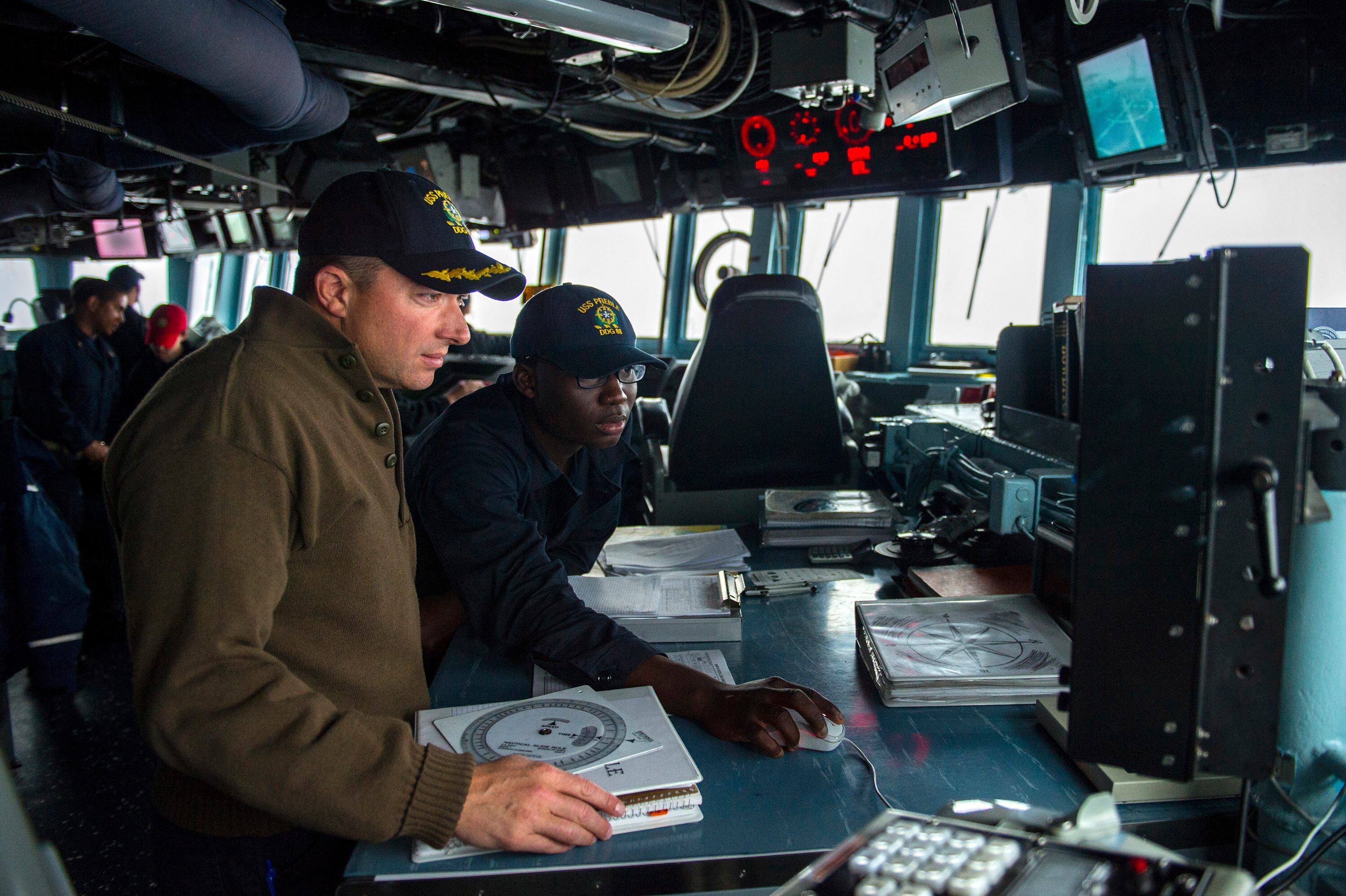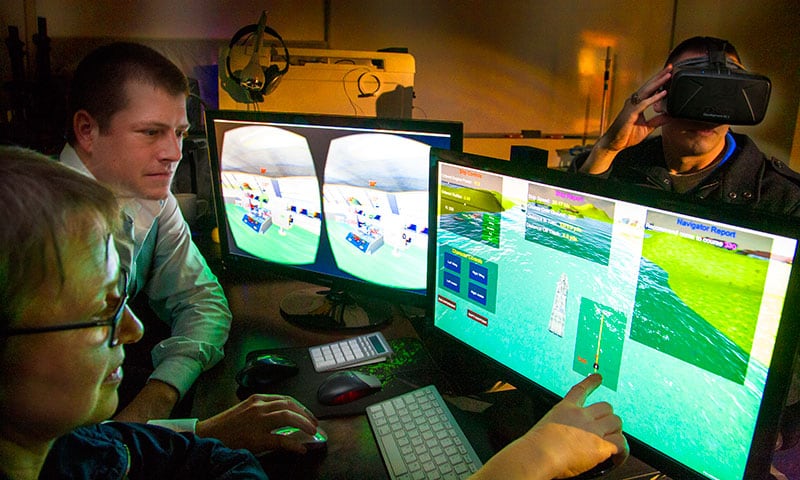Navy Secretary Ray Mabus' office announced the winners for the inaugural SECNAV Innovation in February, and of the nine categories, three were taken by active-duty sailors.
An open-source code that can immediately spot suspected submarines in sonar returns. A heads-up display for surface warfare officers. A ship crew that came up with 60 solutions.
Those projects won their makers the inaugural SECNAV innovation awards, with prizes ranging from choice orders to $5,000.
Three of the nine categories were won by active-duty sailors. They spoke to Navy Times about their award-winning projects and what's next:
One is a destroyer commanding officer, another is a lieutenant fresh out of Naval Postgraduate School, and then there's the chief sonar technician who taught himself to code and is changing the way ship analyze sonar.
Winners were nominated by their peers through SECNAV's innovation site, and winners can choose from a range of prizes, from a $5,000 cash to orders of their choice.
Here are some of The top projects:
Enlisted Innovator: Chief Sonar Technician (Surface) (SW) Benjamin Lebron, Destroyer Fitzgerald; Yokosuka, Japan
Lebron, who served six years in the Army before his discharge in 2000, was determined to get back into the military after 9/11. The Army offered to let him return as a public affairs photographer, but a Navy recruiter offered him a job that was more in the fight, he said.
Now on his third Japan-based ship, all while based in Japan, the 39-year-old Lebron has rewritten the way his division analyzes sonar data.
"We've had these really archaic methods of doing things," since the end of the Cold War, he said, when anti-submarine warfare was a hot topic. "Right now in my sonar control room, I have a computer that moves slide-rule plastic discs. It was copywritten in 1974."
Lebron figured there had to be a faster way to analyze his data.
"I'm spending the majority of my time constructing these plots and drawing out these lines and these circles and these graphs," he said.
So he started with an Excel spreadsheet that he programmed to crunch the numbers for him. But you need Microsoft Office to run it, he said, so he converted the algorithm to online code, which only requires an internet browser.
Dubbed the Single Leg Bearing Range, the code can spot sonar returns that look like calculates submarine movements instantly.
"My project automates all that stuff, so I can focus on analyzing that information," he said. "What does that circle mean, what does line mean? Instead of spending time drawing it."
Lebron taught himself to code by Google search, which brought him to online resources like Khan Academy to get the math right, and Code Academy to show him how to put together the lines.
"What's great about the web platform is it's not a language like C Sharp or C++ where you have to compile it. It's just HTML and Javascript," he said.
Now he can tweak it to do whatever he tells it to do, and apply it to other ships.
"My buddies have written me back and been like, 'Hey, this is pretty good. Can you make it do this?' And I'm like, "Yeah, give me a couple days."
Lebron is deciding whether to take a specialized training opportunity or an innovation fellowship as his prize, he said.
Innovation Leadership: Cmdr. Jeffrey Heames, CO of the destroyer Preble; Honolulu, Hawaii

Cmdr. Jeffery Heames won an innovation award for creating a culture that harnessed sailor ideas on destroyer Preble.
Photo Credit: MCSN Alonzo M. Archer/Navy
After taking command of the Hawaii-based ship in 2014, Heames released a ship-wide instruction, specifically asking his crew to come to him with their suggestions.
A former enlisted electronic warfare technician who's served for with 24 years under his belt, Heames was recognized for leading an innovative command that incubated, which has come up with almost 60 sailor-generated ideas.
"Most ships do that. Most units are looking at ways to innovate," he said in a phone interview. "I think we just had a program that was very, very effective in that it produced a large number of ideas and concepts, and some of them were very useful."
Those concepts and proposals were mostly geared toward improving warfighting, tactics and performance as a whole. Many of them are classified, he said, but involved re-purposing existing systems for different applications.
For example, he said, a junior nuclear-trained officer suggested using the Navy Nuclear Power Program's root cause analysis process beyond looking at failures, and applying the same principles to areas of the command that are under-performing.
"There is a spillover effect," Heames said of his instruction. "Even though we were focused on tactical warfighting and operational performance, the spillover into safety innovations, process improvements or other areas is just a natural thing."
Another idea came from two E-4s, an E-5 and an E-7, he added, and he initially rejected it. But they kept bringing it to him, and now it's one of the most significant proposals he's gotten.
"I think it was just having a culture where they can come to me, and they can push back and say, 'No wait, Captain. I think this is really a good idea,' " Heames said.
Though he was offered a choice of prizes, a spokeswoman confirmed, he ultimately decided not to accept any reward.
Innovation Scholar: Lt. Brendan Geoghehan, 7th Fleet; Yokosuka, Japan

Innovators like Lt. Brendan Geoghegan say they're making headway to develop new systems that aim to improve the Navy, like a heads-up display for ship navigation.
Photo Credit: Navy
Geoghehan, 28, is the first to admit that his project has no practical Navy application in the Navy for the foreseeable future. But it could be a game-changer — a heads-up display for shipdrivers.
While studying computer science at the Naval Postgraduate School last year, he came up with the idea of using augmented reality to help navigate ships. Using a $500 augmented reality developer's kit, he built a simulation that would allow surface warfare officers to wear their displays over their faces and overlay virtual information onto the real-world picture, the way a pilot's cockpit heads-up display works.
"Really, I don’t honestly thinkg that this will be implemented any time in the near future just because of technological considerations, and the cost," he said in a phone interview.
"It'd be really cool as a navigator to say, pop-up! There's a turn coming. Or, pop-up! There's shoal water over there. Or, pop-up! You're going too fast," he said.
The Navy is experimenting with augmented reality now, using Google Glass, but those applications are so far limited to lower-stakes ventures, like loading a publication so that a technician can read a tiny screen over his eye rather that go back and forth with a heavy manual.
And, Geoghegan wants to see that technology applied to core Navy missions, like navigation where real-time information could improve decision-making. said, that technology could be applied to navigation.
"So that's what I did, knowing that no SWO in his right mind would allow me to go to a real warfare ship and test out with Google Glass and say, 'Hey, do you mind if I drive this track really close to land with new technology that's never been used before with a computer that I'm not even supposed to be touching?' "
So using his kit and free online software, he built a simulation, like a level in a video game.
"I built a level that ran someone through 20 minutes of driving a ship, and this 20 minutes was three different scenarios based on whatever method I was using," he said. "One of the methods included using this heads-up display in the virtual reality, so they could actually see what it would be like to drive with that HUD."
Using the technology on-board is years off, though, he said, with a system building built to get live feeds from electronic charting systems and the navigation team, while also meeting cyber security requirements. Even for something like Google Glass, the Navy has to look at the cyber security implications of using wireless displays on the ship.
Geoghegan hasn't made a decision about his prize, he said, but he isn't considering the cash award.
Meghann Myers is the Pentagon bureau chief at Military Times. She covers operations, policy, personnel, leadership and other issues affecting service members.





